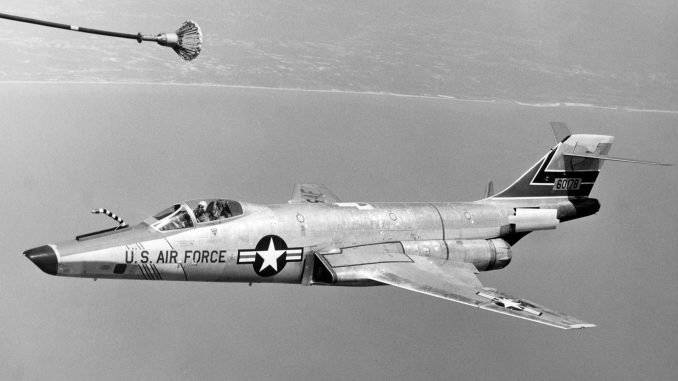
By Robert F. Dorr
Jim Brickel called it ‘flying in the barrel’. To take the RF-101C Voodoo over North Vietnam, a pilot had to stake himself and his aircraft against flak, fighters, and the ever-present danger of some awful mechanical catastrophe within the churning guts of a complicated aircraft that, as Brickel put it, “felt like a thousand pieces of metal grating against one another and trying to rip everything to pieces.” The citation for Brickel’s award of the Air Force Cross, the second-highest U.S. award for valor, speaks to the March 10, 1967 mission in which Jim “led a flight of two RF-101C photo-reconnaissance aircraft on a bomb damage assessment mission against one of the most highly defended targets in North Vietnam.”
The citation continues: “Despite a direct hit by anti-aircraft artillery flak that extensively damaged his aircraft, Colonel Brickel continued to the target and acquired one hundred percent photographic coverage. He then made a successful withdrawal from the hostile territory on a single-engine and landed at his home base.” The citation refers to Brickel’s “aggressiveness in the face of hostile forces.”
Brickel belonged to the 20th Tactical Reconnaissance Squadron, the “Green Pythons,” stationed at Udorn, Thailand. His squadron commander, Lieutenant Colonel (later, Colonel) John Bull Stirling, led a similar, two-plane RF-101C mission over Kép airfield 16 miles northeast of Hanoi nine days before Brickel did. Stirling said he wasn’t worried about any MiGs because, “I could simply stay at full power and leave him in the lurch.” Although more recent warplanes can fly faster than the Voodoo did, Brickel, Stirling and other RF-101C veterans believe their aircraft carried out the fastest missions ever to be flown in combat, before or since, with the exception of those flown by the SR-71 Blackbird.
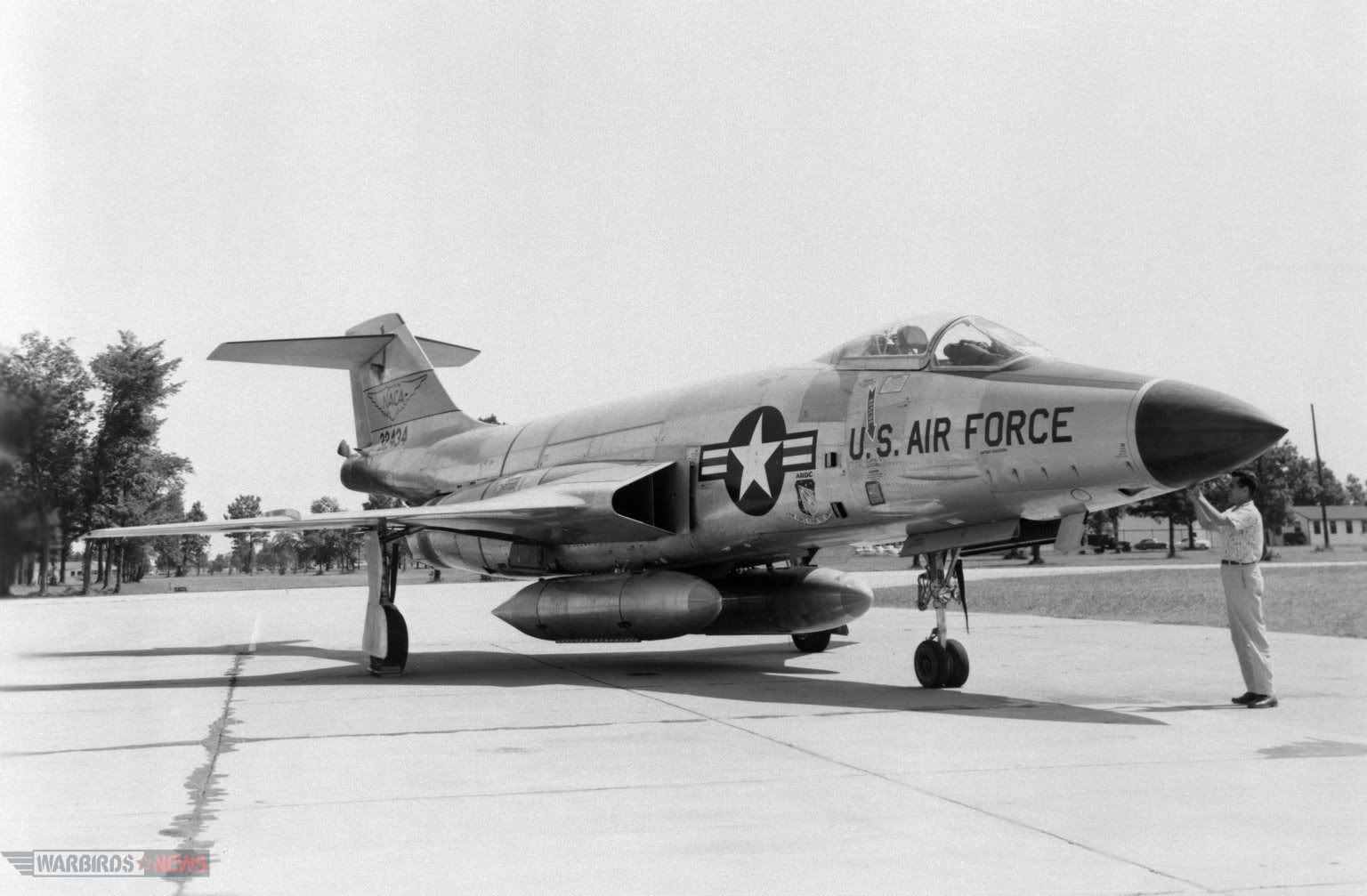
Big and bad
The F-101 Voodoo was a product of the great fighter dynasty founded by James S. McDonnell in St. Louis, Missouri and inherited by today’s Boeing Corporation. The F-101 was big, heavy, sturdy, and fast. It was unforgiving. Some pilots say it was more difficult to fly than any other warplane that ever entered squadron service. As a reconnaissance craft, the RF-101C challenged North Vietnam’s missiles and MiGs. As an interceptor, the Voodoo guarded North America wearing US and Canadian markings. The Voodoo had a pitch-up problem caused by the way air flowed over its wings and under its high tail. The tendency to unexpectedly jerk into a nose-high attitude killed several pilots. A pitch inhibitor, or “stick knocker,” installed in mid-life, was little help. The Voodoo’s twin Pratt & Whitney J57-P-55 turbojets turbojet engines on full afterburner kicked back 16,900 pounds of thrust (75.2 kN) each. The fuselage of an F-101B at 67 feet 5 inches was about a yard (or a meter) longer than that of a DC-3 transport. In 1946, McDonnell began design work to meet a U. S. Air Force (USAF) requirement for a “penetration fighter” to escort bombers to their targets. Several variations on the XF-88 fighter (created by repeatedly modifying the two built), also were tested in the late 1940s ahead of the F-101. The XF-88 was also given the popular name Voodoo. When the spectacular F-101 finally burst on the scene, it served not as a “penetration” escort but in three other capacities — as a bomber, a reconnaissance ship, and an interceptor. Despite being a monumental challenge to its pilot, it was a superlative aircraft and very much a product of the tensions and the atomic planning of the Cold War.
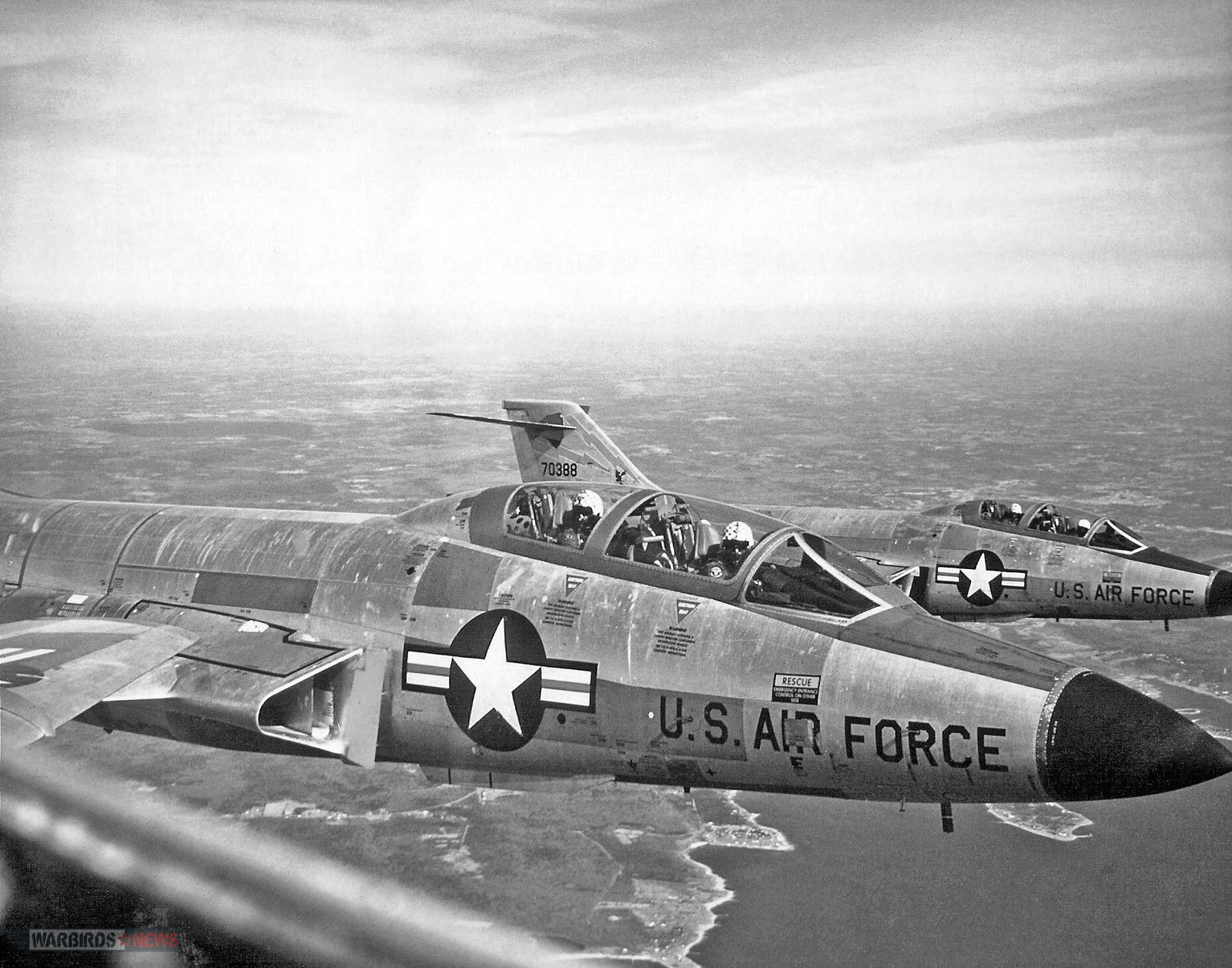
Atomic bomber
McDonnell test pilot Robert C. Little made the maiden flight of the first F-101A in California on September 29, 1954. It appears to have been the first aircraft ever to go supersonic on its initial sortie (a feat Little was unable to replicate when he made the first F4H-1 Phantom II flight on May 27, 1958). Like the F-101C to follow, the F-101A was armed with four 20-mm M39 cannons. The F-101A, enjoyed a brief career as a one-way, single-mission atomic bomber, powered by J57-P-13s. Typical ordnance was a single Mark 7 hydrogen bomb mounted beneath the left-wing.
The F-101C was heavier than the A, with structural improvements which increased its G tolerance from 6.33 to 7.33. Otherwise, F-101A and F-101C were interchangeable. American F-101A/C Voodoos deployed to Formosa during heightened tensions in 1958. To bring the Voodoo’s striking power closer to the Soviet Union, the F-101A/C moved to Britain’s Royal Air Force Bentwaters/Woodbridge air base, replacing the F-84F Thunderstreak. The 81st Tactical Fighter Wing there was commanded in the early 1960s by air ace Colonel (later, Brigadier General) Robin Olds, who took the audacious step of forming a Voodoo flight demonstration team in the manner of the Thunderbirds or Blue Angels. Olds often spoke of the roominess of the Voodoo cockpit and the satisfaction that came with mastering its pitch-up problem.The mission of the F-101A/C was to fly out to a distance as great as 1,000 miles (1610 kilometers) and drop a single, tactical nuclear weapon on a Soviet or Eastern European target. The F-101A/C’s low-altitude bombing systems were mazes of gyros, timers, and computers permitting the aircraft to drop its Doomsday load after attacking at almost treetop altitude. Crews never trained with conventional bombs.
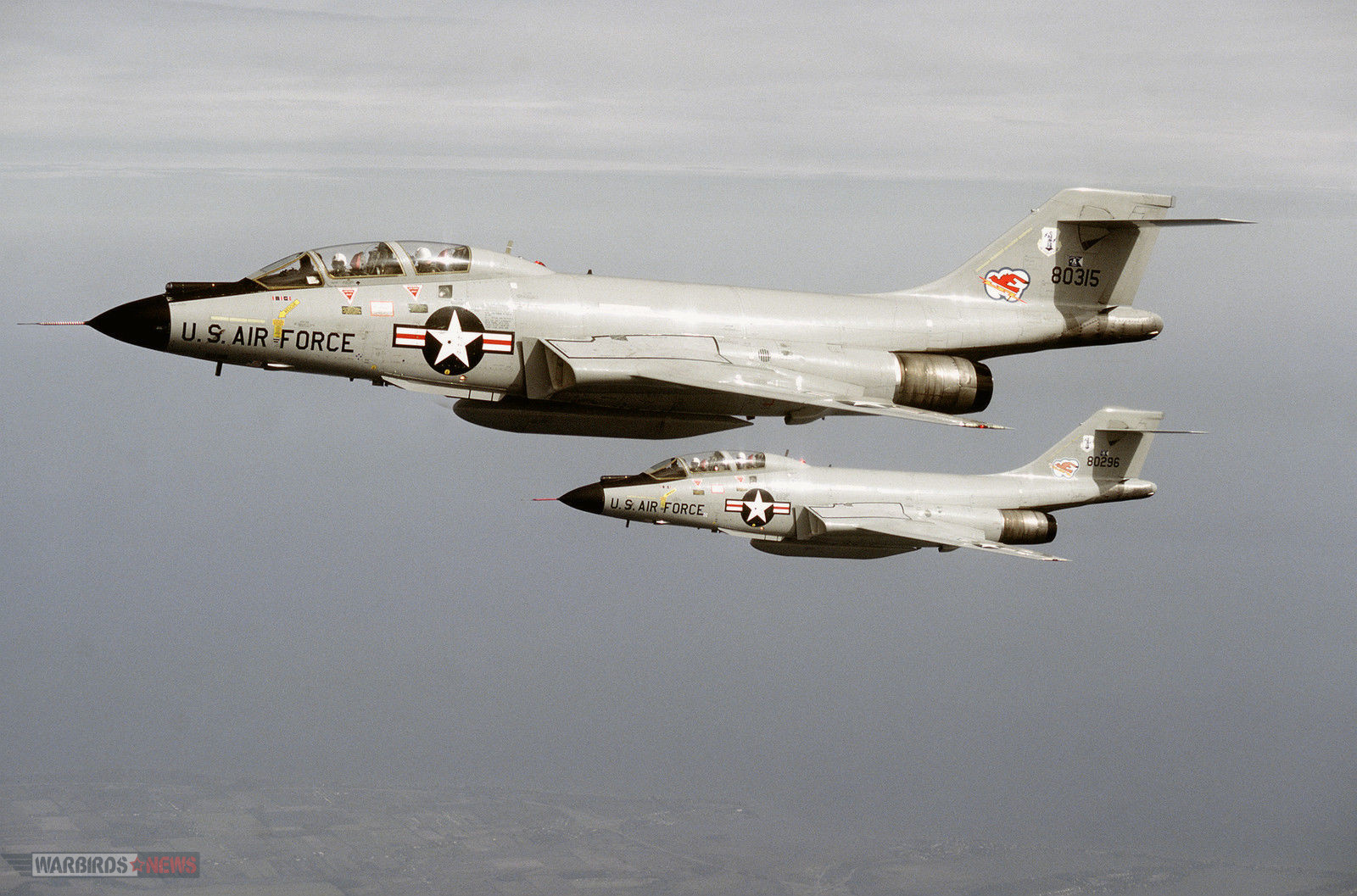
Reconnaissance Voodoos
The RF-101A and all reconnaissance versions of the Voodoo, carried up to six cameras. On November 26, 1957, an RF-101A flown by Gustave B. Klatt set a west coast (Los Angeles to New York to Los Angeles) transcontinental record of 6 hours 42 minutes 6.9 seconds. On the return leg, Klatt set an east-west record of 3 hours 34 minutes 8.6 seconds.
After the RF-101A came the RF-101C with stronger wing structure. This became the only Voodoo to see combat in American hands. Chinese Nationalist pilots flew both A and C models of the reconnaissance version into harm’s way over the Chinese mainland. The RF-101C first flew in 1957. The RF-101A/C had a critical role in the 1962 Cuban missile crisis: Voodoos deployed to Florida and flew 82 combat sorties. The RF-101C Voodoo flew from three locations against North Vietnam. RF-101Cs later served with Air National Guard (ANG) squadrons. The RF-101G was a conversion of the F-101A bomber (below) to become a single-seat reconnaissance aircraft (corresponding to the RF-101H conversion made from F-101C models). The first RF-101G conversions went to the Kentucky ANG in 1965, replacing the RB-57B Canberra. The RF-101G was also employed by the Arkansas ANG in 1972. The RF-101H was employed by the Nevada ANG at Reno from 1965.Alongside the RF-101G, the RF-101H was also employed by the Arkansas ANG. The RF-101B became the final reconnaissance Voodoo and the only version with a back-seat crew member. The USAF converted 22 ex-Canadian F-101B interceptors (below) to RF-101Bs
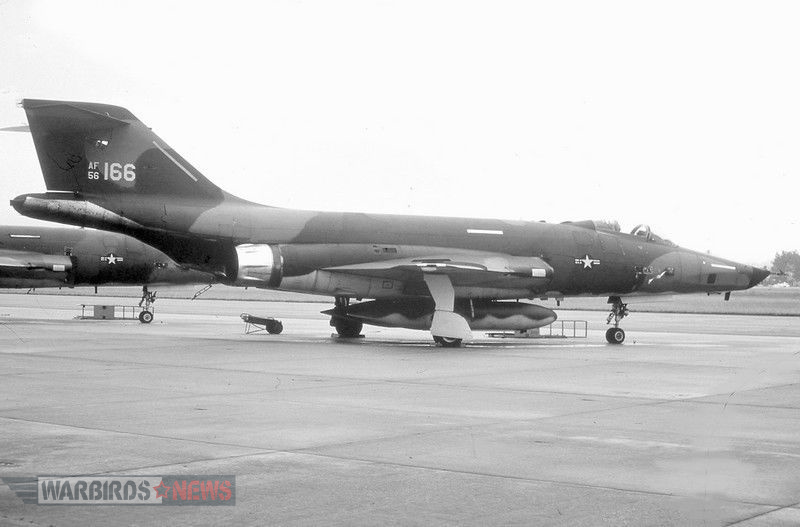
Guarding North America
The F-101B (originally, F-109, a designation often mistakenly attributed to a Bell design) was the two-seat, long-range interceptor. McDonnell built 479 examples for the Air Defense Command (ADC), making this the most numerous Voodoo. The armament initially comprised two Hughes GAR-8 (AIM-4) Falcon missiles. The F-101B was modified in 1961 to carry two MB-1 (AIR-2A) Genie rockets with atomic warheads, designed to scatter incoming Soviet bomber formations.
The F-101B entered service in 1959. F-101Bs stayed in ADC until 1972. The ANG operated the F-101B from 1969 to 1982. F-101Bs built or converted as “two-seat dual control aircraft” were redesignated F-101F long after the conversion took place. Some F-101Fs were among the 132 F-101B/F interceptors flown by Canada. McDonnell buit 807 Voodoos of all versions. The U.S. taxpayer shelled out $1.28 million for an RF-101C and $1.75 million for an F-101B. The last Voodoo to fly in the United States was an F-101B piloted by Lieutenant Colonel Bruce Sanders at Tyndall Air Force Base, Florida in September 1982. Numerous Voodoos survive in museums. The very first aircraft, an F-101A (53-2418) was with the museum in Pueblo, Colorado in the 1990s but we were unable to learn its current disposition.
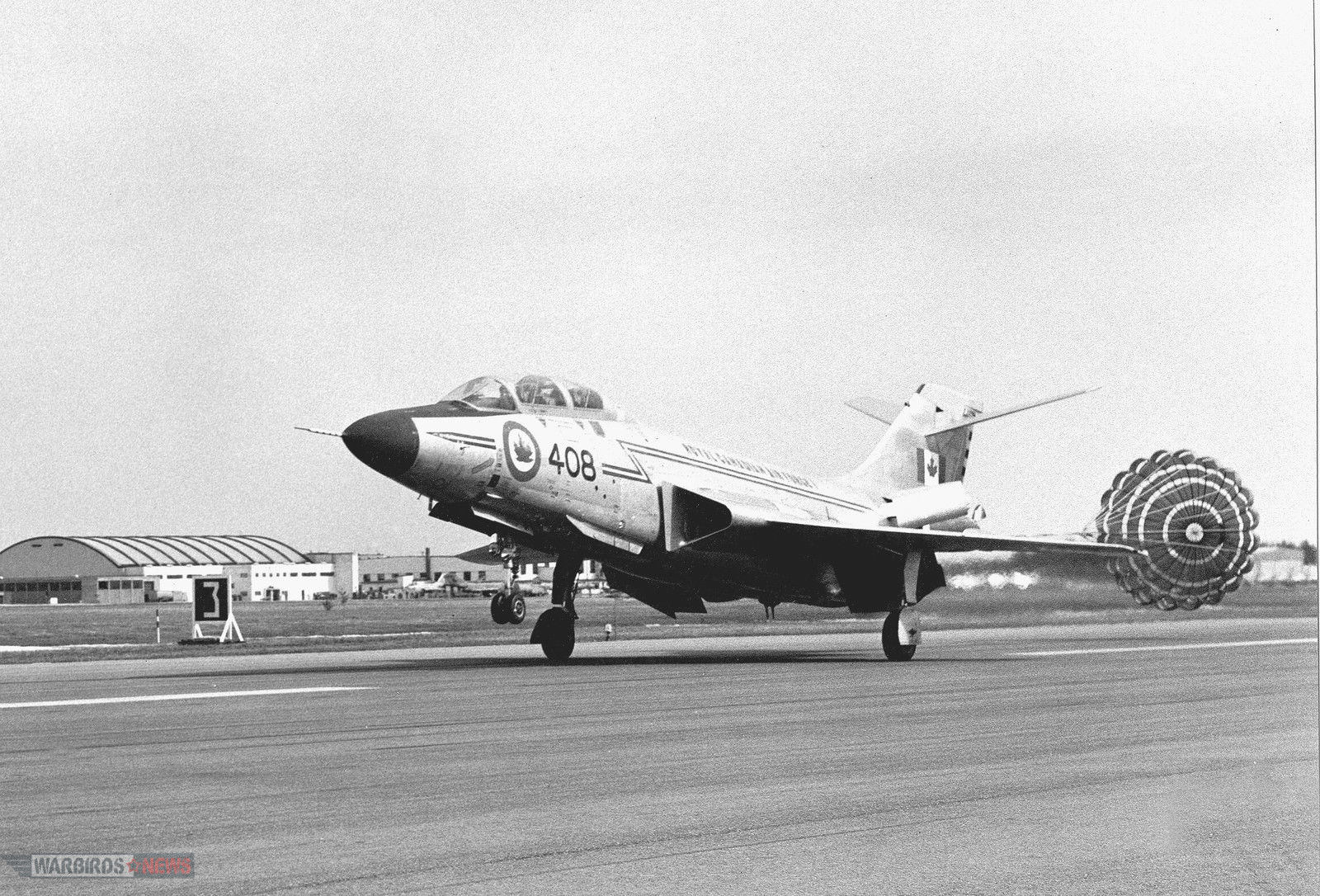
Warbird world
It’s exciting to imagine a warbird aficionado returning a mighty Voodoo to flying status and wringing it out in front of audiences at air shows. Sadly this will never happen. The handful of Vietnam-era fast jets in private ownership, such as the Collings Foundation’s F-4D Phantom II, are the result of one-of-a-kind authorizations supported by Capitol Hill and there is no mood in Washington for more of the same today. In 2007, I talked to key figures including the then-Air Force chief of staff General T. Michael Moseley about Collings’ interest in restoring and flying an F-105 Thunderchief. Wise and prudent plans had been made and the means were there, but it wasn’t going to happen. Congress, the Executive Branch and the Air Force, including Moseley, were adamantly against it. In the case of the Voodoo, it’s unlikely anyone has the means—and while faces change inside the Washington Beltway, institutional opposition is deep-rooted.
About the author
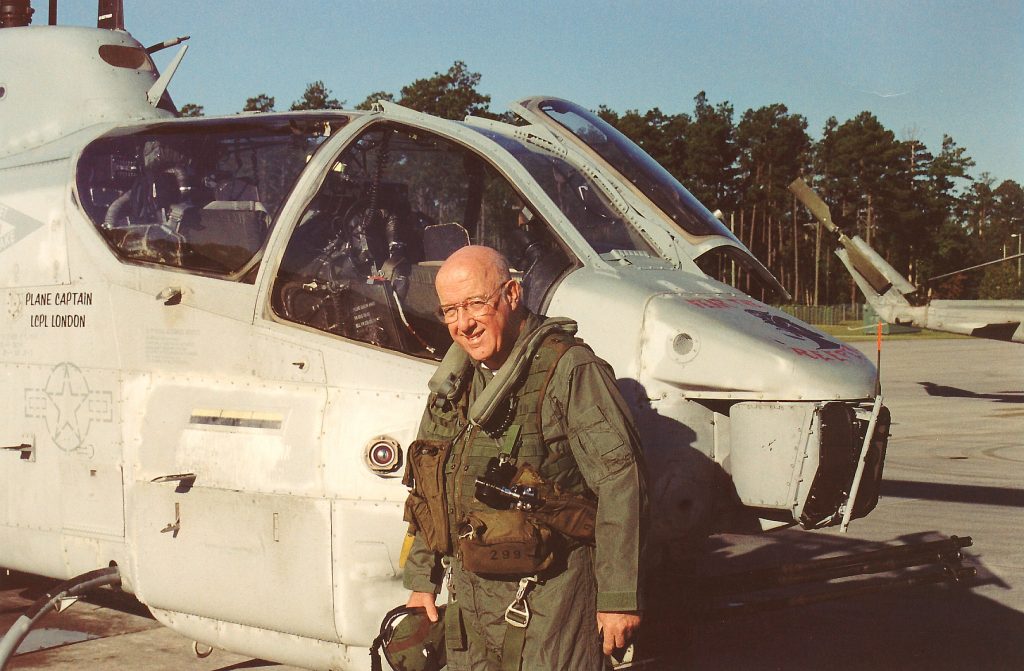
Robert F. Dorr, Warbirds News staff writer, is an author (since 1955), an Air Force veteran (1957-60) and a retired U. S. diplomat. He has written dozens of critically acclaimed books, and literally thousands of articles on aviation topics. He recently published his first novel, an alternate history entitled “Hitler’s Time Machine,” available for Kindle and in print here:
http://www.amazon.com/dp/B00R08P4UQ
Click HERE for the complete Century Series articles


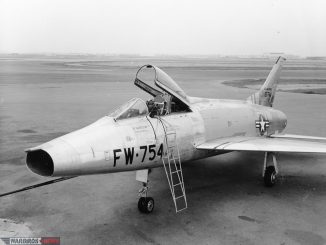
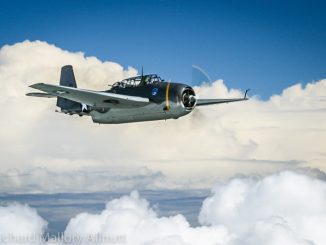
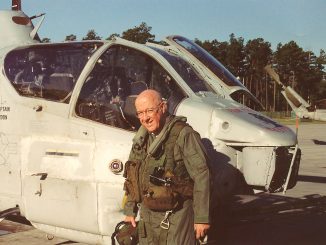

Merci pour ces superbes photos du Woodoo reco. J’ai habité à Toul pendant deux ans de 60 à 62 et nous étions parallèle à la trajectoir de descente des avions se posant à TRAB.
I have worked at Donaldson Center in Greenville SC for 20 years. There is NO F-101 Voodoo here…sorry
Sorry, bud. I was a Medicine Man for several years at Shaw, Ton San Nhut and Udorn. I worked on Voo Doo A’s, B’s, C’s and RF-C’s. Your assertion of the absence of 101’s is completely erroneous. I even çonsidered applying for work but opted for construction, then Westinghouse and finally Lockheed. The Voo Doo’s were in for mods in 1975 at Donaldson Center, Greenville, SC.
I was assigned to 20TRS at TSN and Udorn. I remeber those times well.
There is no F-101 VooDoo at the old Donaldson AF base in SC
Many thanks for your comments Leonard Morgan, we appreciate the confirmation. The error was on my part (Editor), rather than Robert F. Dorr’s. I’ve amended the article accordingly. Many thanks indeed for reading!
I have memories of my father, Col. E. G. (Irish) Ireland, recounting with some passion, the feeling of the after burner kick-in on the Voodoos of 409 (Nighthawk) Sqdn. at CFB Comox back in the early 60’s.
Hello Rob, I served with your Dad, then Wing Commander (Irish) Ireland, back then and have very fond memories of his great leadership….
Cudgel 13
Per Ardua
Hello Rob, I, also was on squadron with W/C Ireland in the 60’s. I believe I was on 409 again when he was Base Commander in the 70’s.
I had the honor of attending his wake , but don’t remember meeting you. I do remember “Wind beneath my Wings”.
Per Ardua,,, Doug
Rob, I don’t think we’ve met, but I recall your father fondly. He was retired when I flew with 409 from ’79 – 83. I can’t remember when he moved back to Comox, but we used to hold the aircraft down on takeoff to make sure we passed over your house off the end of Runway 12. Needless to say, there were never any noise complaints!
I flew the F 101B/F for 3 1/2 years at Otis AFB(60th FIS) and 1 1/2 years at Tyndall AFB(IWS) . I was an IP and Test Pilot at both bases. I have accumulated over 1300 hours in this airplane. Because it was a 2 man crew it was the best of all 3 ADC interceptors, by far
I was in the autopilot shop of the 60th at Otis AFB, 1960-1964.
Sorry I do not remember you but I do recall a Captain Allan Drew was our test pilot for awhile. We also had a great civilian rep. from Honeywell to provide technical advice on the MB5 Autopilot. He was Dick Hanking.
Great organization, lots of good people, and a great experience to support the Voodoo.
This is the first editorial about the 101 voodoo I EVER READ FOR A LONG .
As being one of the group to be trained on the voodoos by the US AIR FORCE in RCAF station Uplands in 1961.
after the course serve five years on them at various bases and enjoy every one of them as the voodoo was probably the best and most dependable aircraft the RCAF had.
The j57 was the and is still the best twin spool engine that Pratt-Whitney ever produce.
There are five voodoos on display that I know of in Canada.
AL
There are four that I know of in Alberta alone – Edmonton(2), Wetaskiwin(1), Calgary(1).
An interesting side note regarding Robin Olds’ formation of a display team with F-101C models is that he knew his forming of the team was not authorized. Having not been deployed to Korea to fight MiGs, Olds correctly calculated that the brass would come down on him and send him to Vietnam as punishment. In Vietnam, he would capably command the 8th TFW and shoot down 4 MiGs.
Cam Rahn Bay. TDY picking up a RF 101C from Udorn. Had to leave it – no engine to swap. As I recall there was a shoot down while we were there. Big Celebration!
Thanks for the great story on the Voodoo, the most under rated plane in the USAF inventory… In 1961-63 had the privilege of serving as Flt-Surgeon to the 98th FIS… What a great squadron… Taught me to run the radar on the 101 and allowed me to fly on many high altitude practice (day and night) intercepts… Great memories of fine men and an exciting plane.. In my first flight the ops officer took off with both burners and tried to wring out the “new” flt. surgeon… Never to forget those great guys…
Remember photographing some of the last active duty F-101B aircraft at Tyndall in 1981. ADWC had a great fleet of vintage aircraft then: T-33, F-101B, PQM and QF-102, and F-106.
I launched the last one, transferred to Canada in 1982 58-0300, got many incentive flights, Moved to T33s after they left.
The Jet Aircraft Museum in London Ontario Canada is restoring an F-101 Voodoo to flying status. It just started and will take a while but lets hope it happens.
Please let me know the status and contact info for the project, if you can! My father-in-law worked on the One-O-Wonder at times in his 26-year USAF career, and I am the LAST active-duty USAF airman to spend his (or her) entire 4-year enlistment as an Analag Flight Simulator Specialist (AFSC 34153) on the F-101B Voodoo flight simulator. Tyndall AFB had the last active AF 101 sim, and it was scrapped a year after I got out. My father-in-law and I would LOVE to see another Voodoo grace the skies!!!
Hi Terry!
Did you ever get a chance to talk to F-101B pilots and RIOs and ask them how the F-101B Simulator was compared to actually flying in the front seat and the back seat?
Thanks!
pete
Voodoo to you, Pete! The sim techs usually talked to the pilots and RIOs (Scope Wizards) as they critiqued the sim after each mission; sadly, the spare-parts
situation for the sim caused problems. Under the last two years of Carter, money was tight, for equipment AND fuel; several pilots swore they’d had enough of curtailed flying hours and increased sim time, and were going to get out and fly for airlines! With no “motion” and the sim sitting on the concrete
floor inside the hut, I doubt it was much competition for the aircraft!
I would love to speak with any camera techs that worked on the RF-101Cs stationed in Saigon or Thailand from 65-73.
You can PM me or check our my website. Thank you.
a great bird, i was a crew chief for 58-283 29fis malmstrom afb
those were good day and good c flight
Hi Duane !
I have never been to Malmstrom AFB, and have a Question for
you =
How did extreme Cold Weather affect maintenance and flyability
of the McDonnell F-101B Voodoos?
Thanks !
I worked in the F101b at Malmstrom AFB MT 663 -64 we did not have many cold weather problems . but was cold working on them on the flight line, like with changing Air bottles in the Intake
Gil, I was with the 29th from 1/65- 1/68 the last 2 years I had the com/nav at Billings Det#1 and Dale Johnson had my back at Malmstrom.
That was a great Bird, I auggied at GF and Billings
loaded on some real nasty cold days, we complained, the birds didn’t.
when were you there? I was at the Com/Nav shop 1/65-1/66 an d then down at DET#1 til 1/68
My dad flew these 1973-1977 and then 1979 – 1982 for 425 Alouette Sqdn, CFB Bagotville. He has so many crazy stories.. on a cold day, they would start retracting the nosewheel while still on the ground (wheelieing) otherwise it would be going so fast the air would prevent the nosewheel gearswing forward and into the wells. Going supersonic low following the rail lines north of Val D’Or, photographing the same TU-95 tailgunner enough times they sent him a care-package through the USSR embassy in Cuba, the list goes on. He was in the Cdn Warlocks 4-ship demonstration team as well. THey would come from behind at 0.95 Mach and scare the bejesus out of folks.. heart attacks and women going into labour.. so they had to stop doing it.
Lived on Grand Island, NY as a kid ’69 to ’79 and vividly remember the Voodoos flying out of Niagara Falls ANG base overflying the island and occasionally going supersonic. Loved seeing an F-101B streak silently across the sky followed by a boom and the sound following it like a ghost after it was long gone! A rare and exciting memory.
My Dad flew the Voodoo. My first memory of them is when the family joined Dad in France at Laon AFB. I was six.
We stayed in the BOQ for a few days before moving into a house off base. I recall being awakened before dawn by the BOOM-BOOM, BOOM-BOOM of Voodoo afterburners being lit as they took off in pairs.
In his 20 year career Dad flew many planes, but the Voodoo was his favorite. I have some good stories from him, including one where he departed Kirtland AFB, did a burner climb, and leveled out at 35,000 feet 1:58 after take-off.
Dear David
I was a jet engine mechanic at Laon for two years, I was there from June 64 to June 66 and I probably worked on a plane your Dad flew if he was there at that time.
RF 101C…
I have two flight suits, with 15th TRS Cotton Pickers and Voodoo patches, of a pilot shot down on his 21st combat mission, along with his wingman, fairly early in the Vietnam War, while on photo recon over North Vietnam. The last contact with the pilots was a “He’s on fire…” with no call sign to identify which pilot. The archive contains all his Air Force paperwork… from his letter of acceptance to cadet training in 1952, through his pilot evaluations, RF101 training evaluations, yearly pilot flight hours, every year, from 1954 to 1966, photos of his 1950’s Air Rescue (Labrador) and transport airframes, as well his supersonic RF101C (along with photos of damage caused in refueling incident in 1966, when both external fuel tanks were torn from the plane during nosedive/near crash, and incident report… see pics). He is credited with saving the Air Force a million dollars by not bailing out when told to… hand written 6 page incident report of his hitting a buoy while in air sea rescue in 1957, full hand written notebook while training in RF101s, i.d. card photos, official NVA photos of his crash site from 1966 (he was technically MIA until 1989, but not identified until 1998), all his certifications for all the aircraft he piloted (he made senior pilot in 1957), letters from various presidents on White House stationery to family…. he was personal pilot for a Vice Commander. Probably a thousand pages from his Air Force career… plus all the MIA material, including a Xmas package sent to Hanoi in 1968, but returned unopened.
As extensive of an archive of a pilot that could be imagined, not to mention one being shot down, and the years in MIA status, which generated post-KIA correspondence and paperwork.
Very nice Matt. Are you looking to donate these items to a museum?
Noted a few guys worked Malmstrom AFB Great Falls Montana and the 29th FIS, I worked the Com/Nav shop at Malmstrom and at DET#1 in Billings from Jan 1965 thru Jan 1968,,, Worked the FL and Bench, did auggie as a B or C man, our team did the fastest turnaround ever on a F101 at Billings in 1967. I was in GF when the engine troop got sucked into the intake on the trim pad. Froze a left thumb to the mike button on the throttles doing a preflight in the dead of winter. The bird was way better at the cold than we were. Have jammed a right foot into the wedge on the left intake and had the RIO hold onto the door while I changed out a ARC34 radio with the engines running at idle. We lost Major Mersereau’s bird in Billings, I crewed the bird in Billings that went down north of GF in 1967 maybe, Never knew if I closed that door in the belly that had the micro for fuel transfer that day. Great aircraft, Greater Crews, Best of times.
Pete Richmond,
Worked for Lockheed Aircraft Service Co as jet engine mech on F 100s at Luke AFB starting in late 1966, transferred to Lake Charles, La working as crewchief, eng mech, etc on F & RF 101s, in for IRAN project, back to Luke AFB about 1969 to finish LAS career on F104s. Really enjoyed reading this article and don’t know why I never looked up 101s before.
Forgot to mention that there are 2, if memory serves me, RFs on display at a local airport in Buckeye, Az on Az hwy 85.
Pete, do you live in AZ? if so did you know Gage Merserau?
My 8th grade year I would ride a British charter bus starting at O dark thirty from High Wycombe Air station up to RAF Upper Heyford for school. I remember many a time being a little sleepy and incurring the wrath of some of my teachers for my sleepy demeanor. If a rap on my knuckles with a ruler didn’t get my attention, being “lit” up when the RF 101C’s would depart the base brought me out of my slumber. Roaring One Oh Wonders screamed out from the base and shook the WW 2 Quonset huts in which we attended classes. Those take-offs was a sound I always looked forward too.
Hi Voodoo people, somebody have a info, pictures, story, etc on Val-d’Or airport on 1954-1976 era?
Did lots of work on the autopilot system, plus mods. and wiring with the Honeywell reps. during the late 60ies on F101B’s We had two F101F’s for training and believe it or not, parts pickup. From Lockborne AFB, ohio. we did TDY’s at Wurtsmith AFB, Mi.and Tyndall AFB, fl. Lots of bases.needed help during that time because of S.E.A. They were beautiful planes and loved to work on them. How many out there remember the 87th F.I.S.
I did an evaluation flight in an F-101 in 1976, as part of my experience as a test pilot student at Edwards. At that time I was current in the F-4 and T-38, so I didn’t expect very much, and a few years earlier I had been combat ready in the F-100. Holy cow (that’s a piece of test pilot technical vocabulary)! I wish I had been prepared to take detailed data. My impression was it beat the F-4 time to climb to 40K. I also think it had a roll rate as high as the T-38, maybe higher. High enough to smack your helmet against the canopy and make you wish you hadn’t put the stick over quite so far. Super impressive and a total surprise.
53-2418 is at the Evergreen Aviation and Space Museum, 500 NE Captain Michael
King Smith Way McMinnville, OR 97128.
The stick shaker must have been of some value, since the USAF didn’t lose any Voodoos to “pitch-up” in operational service. All the pitch-up losses were during flight testing.